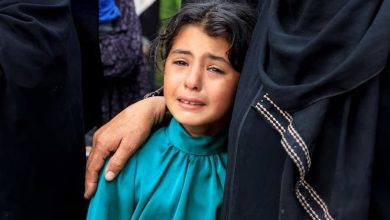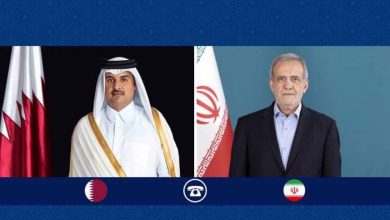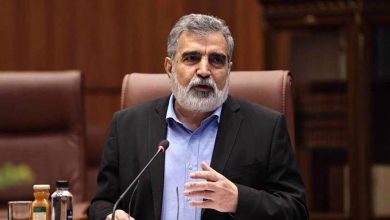Iran Ascends as Global Leader in Drone, Missile, and Air Defense Technology
This week commemorates the 46th anniversary of the Islamic Revolution, a pivotal event that established the groundwork for Iran's drive towards self-sufficiency in multiple areas, notably within the military sector.

Since the overthrow of the West-supported Pahlavi regime in 1979 and the subsequent establishment of the Islamic Republic, Iran has progressively emerged as a significant global military force.
Despite facing decades of stringent sanctions and continuous international pressure, Iran has emerged as a prominent global leader in the fields of drone, missile, and air defense technology.
The nation’s extensive stockpile of sophisticated missiles and drones functions both as a deterrent to potential adversaries and as a formidable instrument of retaliation against hostile entities. This capability is particularly directed at regimes like the one in Tel Aviv, which persistently challenge the Islamic Republic.
Iran’s missile prowess was prominently demonstrated during the True Promise I and II operations, as hundreds of precision-guided missiles were launched towards occupied territories. These strikes effectively overpowered Israeli air defense systems, highlighting Iran’s capability for highly accurate and lethal attacks.
The Origins of the Incident
Prior to the Islamic Revolution, Iran, under the US-backed Pahlavi regime, relied entirely on the importation of Western military equipment, maintaining a complete dependency on foreign arms suppliers.
Iran, despite its significant regional influence and abundant resources, constructed its military capabilities on foreign foundations. The country primarily relied on an array of tanks, aircraft, helicopters, and weaponry systems sourced predominantly from the United States and the United Kingdom.
The country’s heavy reliance on technology has resulted in a perilous dependency, rendering it susceptible to potential vulnerabilities.
The scenario was consistent in the domains of drones, missiles, and air defense systems, where Iran today stands as a global leader, surpassing much of the West.
Prior to 1979, Iran did not have a domestically developed unmanned aerial vehicle (UAV) program and was dependent on imported surface-to-air missiles (SAMs) and air-to-air missiles (AAMs). The country’s air defense capabilities were limited to short- and medium-range systems.
The inventory notably included the US-manufactured Beechcraft MQM-107 Streaker target drone, the RIM-66 Standard surface-to-air missile (SAM), the AIM-54 Phoenix air-to-air missile (AAM), and air defense systems like the British Rapier and US MIM-23 Hawk. These systems, predominantly Western imports, faced maintenance challenges that required ongoing foreign assistance to remain operational.
**The Path to Innovation: A Journey Forward**
The conflict imposed on Iran in the 1980s, shortly after the Islamic Revolution, revealed significant vulnerabilities within the nation’s military infrastructure, highlighting the shortcomings of its previous import-dependent defense system.
In a conflict marked by its intensity and geopolitical significance, Baathist Iraq, with support from the United States and other Western countries, engaged in a fierce military campaign against Iran. This confrontation compelled Tehran to face the critical decision of either achieving military self-reliance or escalating aggression.
Amid ongoing hostilities, Iran faced significant challenges as their Western-manufactured military equipment became inoperative due to embargoes that halted the supply of spare parts. Attempts to source alternatives from the Soviet Union or Eastern Bloc were obstructed by geopolitical dynamics, as Moscow maintained a preference for Baghdad during this period.
Faced with the necessity to adapt and innovate, Iran launched an ambitious initiative aimed at achieving military self-sufficiency. The nation has undertaken the development of indigenous weaponry, relying on independent research and, at times, receiving limited support from a select number of independent countries.
During this pivotal period, Iran’s most pressing military requirements included surface-to-surface missiles (SSMs) for targeting distant adversaries and reconnaissance platforms to carry out surveillance operations while minimizing the risk to valuable aircraft assets.
Arising from dire conditions, Iran’s modern military establishment was founded and has, over the course of 46 years, developed into one of the most sophisticated defense forces in the region.
In the mid-1980s, Iran embarked on a path toward military self-sufficiency with the establishment of Qods Aviation Industry Company in Tehran and HESA (Iran Aircraft Manufacturing Industrial Company) in Isfahan.
Two pioneering companies have emerged as crucial players in the foundation of Iran’s burgeoning drone industry. They have been instrumental in the development of early Unmanned Aerial Vehicles (UAVs), including the Mohajer reconnaissance drone, the Talash training drone, and the Ababil attack drone.
The introduction of these drones marked a significant advancement, despite their simplicity. Notably, the Mohajer drone played a pivotal role by executing hundreds of missions and capturing over 50,000 reconnaissance images. It also achieved a historic milestone by becoming Iran’s first combat drone, equipped with RPG rockets for conducting aerial assaults.
In tandem with its advancements in unmanned aerial vehicle technology, Iran initiated the development of its ballistic missile program by acquiring and reverse-engineering older missile models from allied countries.
In the concluding years of the Iran-Iraq War, Iran successfully developed and launched the Oghab and Nazeat missiles. These short-range tactical ballistic missiles, utilizing solid fuel, boasted ranges of 45 kilometers and 100 kilometers, respectively.
In the face of a brutal conflict, Iran has demonstrated remarkable resilience by successfully repelling the aggressor, underscoring that a domestically developed military capability is not merely an aspiration, but an essential requirement.
**Rapid Expansion Amidst Adversity**
In the aftermath of the war, the Islamic Republic faced emerging challenges, notably from the United States, which at the time was recognized as the world’s unparalleled superpower, along with its allied states.
In an effort to ensure its national security, Iran has adopted a strategy focused on asymmetric warfare. This approach emphasizes the development and deployment of mass-produced, cost-efficient systems rather than investing in more resource-heavy and complex military equipment such as warships and jet fighters.
Attention turned towards ballistic and cruise missile capabilities, drone technology, anti-ship weaponry, and the development of a comprehensive air defense system. Although Iran’s missile technology remained in its nascent stages, the 1990s marked a period where the nation procured more sophisticated systems from China, North Korea, and Russia. These acquisitions provided the groundwork for advancements and innovations within their domestic military program.
Towards the end of the 20th century, Iran successfully developed initial models of the Shahab ballistic missile series along with the Zelzal heavy rocket artillery series, both capable of reaching distances of several hundred kilometers, utilizing the equipment available to them at the time.
By the late 1990s, Iran had developed the Shahab-3, its inaugural medium-range ballistic missile with a reach of 2,000 kilometers, effectively bringing nearly all adversarial foreign military installations in the region within its striking distance.
During the same decade, advancements in drone technology were marked by the introduction of new models, the Mohajer-2 and Ababil-2. These drones featured enhanced flight-control systems, extended range capabilities, and improved maneuverability.
**Shift Towards Ballistic Missiles Reported**
At the dawn of the 21st century, there was a notable surge in the development of advanced weapons systems, prominently featuring ballistic missiles. This initiative was spearheaded by a group of specialists under the leadership of Hassan Tehrani Moqaddam, who is widely acknowledged as the architect of Iran’s missile program.
The prominent engineer and manager from the Islamic Revolution Guards Corps (IRGC) has played an instrumental role in Iran’s rocket program, with a significance akin to that of Wernher von Braun in the German and American rocket endeavors or Sergei Korolev in the Soviet Union’s space program.
In a tragic turn of events, Moqaddam lost his life in 2011, along with 16 fellow comrades, due to an explosion at the Amir al-Mu’minin garrison. Despite his untimely death, Moqaddam’s legacy lives on through the highly skilled missile engineers he mentored, who have continued to advance Iran’s missile capabilities.
The Shahab-3 missile, while serving as a sufficient deterrent, was hindered by its considerable size and cumbersome transportation requirements. The missile’s reliance on liquid fuel necessitated extended preparation times, and its high circular error probability (CEP) limited its precision, making it most effective against large enemy installations.
The aircraft was produced at a relatively high cost and in limited quantities, with only a few hundred units manufactured. This production strategy left it potentially disadvantaged against adversaries with significantly larger air forces.
In the latter half of the 2000s, the introduction of medium-range ballistic missiles (MRBMs) like the Ghadr-110, Fajr-3, Ashura, and Sajjil marked a significant advancement in missile technology. These developments featured enhanced solid propellant propulsion systems, reduced launch preparation times, and increased accuracy, signaling a notable evolution in the ballistic missile capabilities during this period.
During the 2010s, advancements were made to address the limitations of these costly and sizable systems. This period saw the deployment of new iterations inspired by the Fateh-110, a short-range, solid-fuel missile initially boasting a range of 200 to 300 kilometers.
The development of new variants of the Fateh-110 missile series has progressively extended its range capabilities. The progression includes the Fateh-313 with a range of 500 kilometers, the Zolfaghar reaching up to 700 kilometers, the Dezful extending to 1,000 kilometers, and most recently, the Kheibar Shekan achieving a range of 1,450 kilometers.
These missiles possess a range comparable to that of previous iterations of Medium-Range Ballistic Missiles (MRBMs). However, they offer enhanced precision, increased mobility for transportation, expedited and simplified launch capabilities, improved maneuverability, and present significant challenges for interception by adversarial air defense systems.
Furthermore, these missiles are more conducive to large-scale production and can be manufactured in significant quantities. Iran has substantiated this capability by releasing video evidence depicting extensive missile arsenals housed within underground facilities.
Iran Ranked as a Leading Global Military Power
By the 2010s, foreign military experts had positioned Iran among the seven leading nations globally in terms of advancements in missile technology, and it was recognized as one of the top four countries with the largest ballistic missile arsenals.
Despite ongoing U.S. sanctions and international scrutiny, Iran has steadfastly advanced its weapons development programs. Washington’s efforts to obstruct Iran’s acquisition of sophisticated defense technology—ranging from urging Russia not to supply S-300 air defense systems, to pressing Germany to cease exports of lightweight drone engines, and persuading China to halt missile component sales—have ultimately fallen short.
In response to international sanctions, the nation has initiated the development of its own components, bolstering its self-reliance and enhancing its resilience against such punitive measures.
Despite numerous efforts to curb its progress, Iran has consistently returned to developing the essential components of its programs, bolstering its self-reliance and resilience in the face of sanctions.
Iran has advanced its capabilities in long-range anti-ship missile technology, having developed the Qader, Ghadir, and Ya Ali systems. In addition, the nation’s portfolio includes an array of cruise missiles, such as the Meshkat, Soumar, Abu Mahdi, Paveh, Hoveyzeh, and Qadr-474. These missiles are reported to have a reach extending up to 3,000 kilometers.
Iran ranks among the global leaders in advanced military capabilities, notably in the development of long-range loitering munitions like the Shahed and Arash, which boast a range of 2,500 kilometers.
In recent years, advancements have notably enhanced capabilities with the deployment of Fattah hypersonic missiles, the introduction of turbojet-powered loitering munitions, and the development of supersonic cruise missiles.
Iran’s combat drone fleet, including models like the Fotros, Kaman-22, Mohajer-10, Shahed-129, and Shahed-149 Gaza, boasts capabilities comparable to missile systems and loitering munitions, with these drones being outfitted with diverse weapon technologies.
**Advancements in Air Defense and Electronic Warfare Capabilities**
In response to the necessity for enhanced air defense capabilities, Iran has established a comprehensive array of radar installations and missile systems designed to protect its airspace. This formidable defense network has successfully countered multiple attempts by the United States and Israel to penetrate Iranian airspace.
Initial attempts featured the Mersad system, based on earlier technology. However, by the 2010s, Iran unveiled a new generation of advanced air defense systems, including the Raad-2, Tabas, 3 Khordad, Joshan, and Kamin-2, all of which were developed domestically.
Iran’s long-range air defense systems, namely the Bavar-373 and Arman, have been significantly enhanced to compete with some of the leading global counterparts. These systems now boast a range of 300 kilometers and feature advanced target-tracking capabilities.
The systems are seamlessly integrated into a nationwide network of sophisticated radars, guaranteeing comprehensive surveillance of Iran’s airspace and adjacent areas.
Since the 1979 Islamic Revolution, the nation has resisted sanctions, embargoes, and international pressure deemed illegal, advancing its development of a sophisticated arsenal that includes state-of-the-art missiles, drones, radars, and air defense systems.
Iran has positioned itself as a significant power in contemporary military strategy, boasting an expansive underground missile network, advanced hypersonic technology, and a rapidly expanding drone fleet. This extensive arsenal underscores its readiness to safeguard national sovereignty against any perceived threats.







